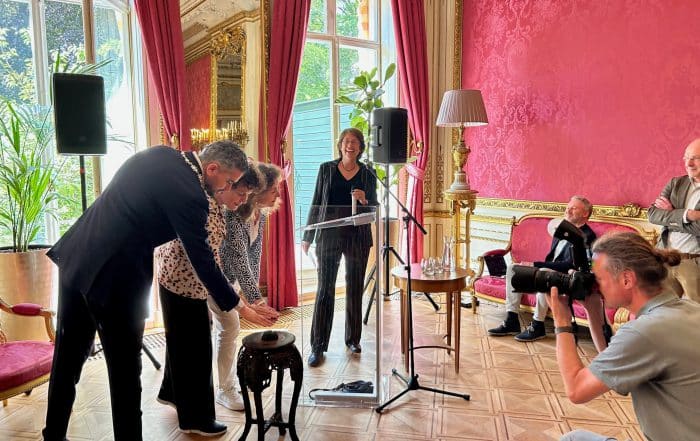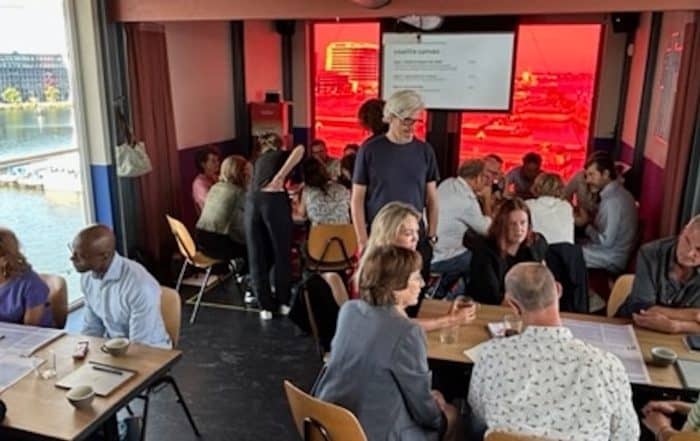No shortcuts for successful AI healthcare solutions
The 25th edition of Medical Data & Pizza reflected the Amsterdam Area’s continued commitment to bringing AI to the bedside in order to improve patient outcomes. Whether it’s convincing doctors to use the latest imaging diagnostics or tracking adverse drug reactions, the key to success appears to be patience, clarity and chipping away on very specific problems.
So why is AI adoption in healthcare lagging? Thousands of algorithms have been developed and many have proven to be effective. Yet only a very few are actually being used. What’s going on?
Bart de Vries is trying to answer this question as a technical physician and a PhD candidate in nuclear medicine at Amsterdam UMC. In his presentation ‘eXplainable artificial intelligence (XAI) in radiology and nuclear medicine’, he outlined the findings of a recent literature review of the same name.
First, he explained the problem. Deep learning is a proven diagnostic tool for a variety of diseases and conditions, with its algorithms particularly adept at quickly picking up anomalies in magnetic resonance (MR), computed tomography (CT) and positron emission tomography (PET) imaging. Certainly, in this arena, the machines have the humans beat.
Unfortunately, these abilities occur in a ‘black box’ and therefore remain largely unexplainable. Hence, many medical professionals – being the evidence-driven people they are – are not ready to blindly trust the results.
Therefore, data scientists are developing explainable artificial intelligence (XAI) to close the gap and shine a light on what’s actually going on. Unfortunately, as the above review concluded, “current XAI methods are neither optimised nor optimal for medical imaging.” In response, De Vries is now researching ways to take XAI to the next level, so it will be embraced by medical professionals.
While he presented various technical approaches, De Vries’ conclusion stressed how the approach should assume some a priori medical knowledge of the context explained by the XAI – while also avoiding unnecessary complexity and tailoring the solution from the perspective of doctors using the technology.
In other words: make it make sense, complete with providence.
Scourge of adverse drug reactions
Joanna Klopotowska is assistant professor in pharmaco informatics at Amsterdam UMC. She introduces herself as a lapsed hospital pharmacist who pivoted to data science after catching the bug. Like De Vries, she’s also a champion of solving specific problems while involving all stakeholders from the beginning.
Meanwhile, she remains true to her original profession by targeting adverse drug events (ADEs) – defined, she explains, as “harm experienced by a patient as a result of exposure to a medication.”
ADEs are a massive real-world problem and the leading cause of injury in healthcare systems worldwide. “And this is while up to 70% of ADEs are preventable. In the Netherlands alone, over a thousand die every year – and these numbers are only increasing,” says Klopotowska.
The reason why the problem is getting worse is that we are living longer. Hence, we are more prone to having multiple diseases requiring multiple drugs treatments. Meanwhile, our understanding on how to prescribe multiple drugs safely – polypharmacy – is sketchy at best.
“We are simply not doing enough to monitor and document ADEs. And what you don’t monitor, you can’t mitigate. In other words, we still need to develop a reliable method to deal with ADEs,” says Klopotowska.
Single use case aiming for maximum impact
But there’s good news! According to Klopotowska, the digitalisation of healthcare and the responsible access to electronic patient records now make it possible to mine for relevant information. And in her presentation, ‘Towards a learning medication safety system by leveraging real-world data and using machine learning and knowledge representation methods (The LEAPfROG project)’, she explained how that project represents an attempt to build a full process to take on ADEs.
“While the focus is on the use case around drug-induced kidney disease in patients with chronic kidney disease (CKD), we hope the developed process can later be generalised for other ADE scenarios,” she added. But meanwhile, the use case itself is a worthy cause: 1.7 million Dutch people are affected by CKD – a progressive disease with no cure that’s the country’s fifth biggest cause of death.
The process comes down to four highly interconnected work packages:
- Data from electronic patient records
- Existing medical knowledge data
- Innovative machine learning techniques to bring 1) and 2) together
- Decision support system giving individualised advice for a particular medication regime
Each work package comes with its own subset of challenges – from the ethics required when mining patient data, to the scattered and multi-structured nature of medical knowledge. And it’s certainly never easy to bring together different data streams that can align enough to offer useable insights that are – yes – explainable. Then there’s the question of the actual end product: How can it be optimised for human/machine collaboration?
Obviously ambitious, the project involves a dizzying and impressive list of collaborators – and all this for a single use case. But as Klopotowska formulates it: “Only through intense collaboration across sectors and disciplines will you be able to bring AI innovations to the bedside faster and more effectively.”
Don’t mention the acronym
During the question period, someone in the audience asked why no one was talking about large language models (LLMs). He seemed surprised and asked, “Is it taboo to talk about them here?”
He hit a nerve. In fact, many in the audience presented many reasons why LLMs were not particularly relevant to this evening’s presented projects, which hope to establish causalities that can have real-world impact on patient outcomes in the short term. For instance, with LLMs, as brimming with potential as they are, there’s still too much to be sorted out – particularly in terms of such innovation touchstones in the life sciences as: explaining ability, transparency, providence, reproducibility and other regulatory essentials. Furthermore, it is worth noting that the privacy-sensitive nature of non-structured medical data required for LLMs are of concern. These concerns revolve around the risk of inadvertently disclosing sensitive patient information, potential breaches, and ethical considerations related to consent, data usage and data sharing.
Down the road, as someone pointed out, LLMs will undoubtedly be part of many solutions. But currently, too many people – and, in particular, companies – are casting LLMs as some kind of cure-all blanket solution, while many medical professionals disagree for the reasons mentioned above.
Luckily, the pizza – that ultimate diplomat – arrived before the group discussion became over-heated.
Are you a researcher looking for inspiration or exposure? You can now sign up on the new AMDS website.
Sometimes medical professionals and data scientists do not sufficiently understand or even know each other at all. Our Right Data Right Now consortium wants to change that!
At the Medical Data + Pizza meetups, we discuss everything related to medical data science, including interesting projects, papers and the latest developments. This is where physicians and data scientists meet. It’s a great opportunity to learn, meet like-minded healthcare professionals, researchers and data scientists, get feedback on your own projects and have fun.
Read the reports about previous Medical Data + Pizza Meet-ups.
The Amsterdam Medical Data Science Group meetings are supported by The Right Data Right Now consortium, which includes Amsterdam UMC, OLVG, Vrije Universiteit, Pacmed, Amsterdam Economic Board and Smart Health Amsterdam.
28 September 2023
Read more about
Contact us
Want to keep up to date?
Get the best regional news and events (in Dutch) via the Board Update newsletter
Share this news
Want to keep informed?
Follow us daily on LinkedIn and sign up for the Board Update newsletter.
Read more
- What AI applications are we already deploying for healthcare and wellbeing? What ...
- Adyen is one of the great success stories of Amsterdam’s tech ...
- Together with enthusiastic partners in three coalitions, the Amsterdam Economic Board is ...




